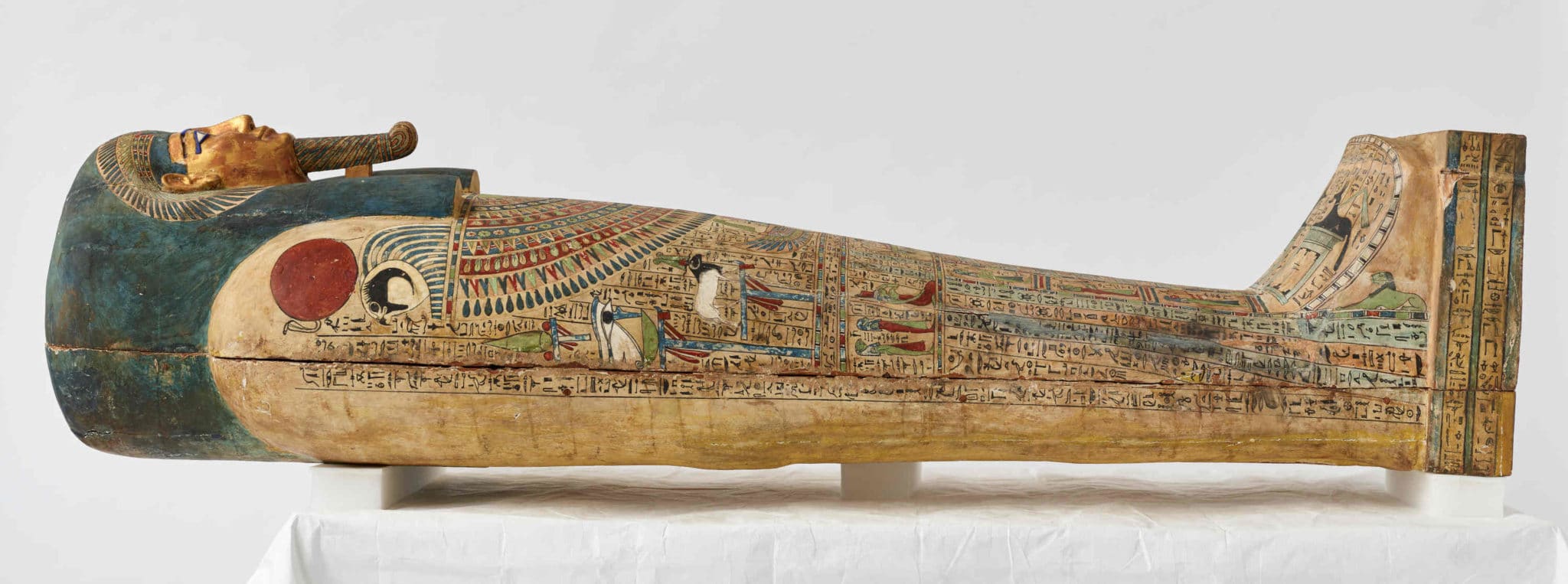The Thorny Ethics of Displaying Egyptian Mummies to the Public
In 1823, the chief surgeon at Massachusetts General Hospital, John Warren, prepared to autopsy a 2,500-year-old corpse. Warren figured examining the Egyptian mummy — a gift from a patron that had been placed in the hospital’s surgical ward to collect quarters from gawkers — would advance knowledge of the ancients. He carefully began cutting through the old linen, and then stopped. He had exposed a blackened but exquisitely preserved head: high cheekbones, wisps of brown hair, gleaming white teeth. As Warren later recounted, this was a person, and “being unwilling to disturb” him further, he stopped there.
Fast forward to last October, when the press was on hand as Egyptian archaeologists opened the first of a cache of 59 recently discovered mummies for the whole world to see, revealing a perfectly wrapped body. Video of the event went viral, and the Twitter pushback followed: “Even in death POC can’t escape the prying and opportunistic advances of white people,” wrote one user, in a tweet that gained nearly a quarter-million likes.
The question of whether it is unseemly, ghoulish, disrespectful, or even racist to display ancient corpses, or whether it’s a noble contribution to science and education, has nagged mummy displays since Warren took up his scalpel nearly 200 years ago. And the Black Lives Matter movement’s focus on issues of cultural ownership and appropriation has only added fuel to a persistent ethical dilemma for museums and experts who study mummies.
The issue is the topic of academic forums and scholarly papers, but the implications are real, both in Egypt and abroad. “It’s a huge subject of debate in our field right now,” said Pamela Hatchfield, the former president of the American Institute for Conservation, a professional association of art conservators.
In April, onlookers watched as 22 mummies were transported to a new museum in a lavish parade through the streets of Cairo. By one estimate, at least 350 institutions around the world display Egyptian mummies, and the abiding fascination with the ancient kingdom of the pharaohs has made those displays a vital draw for museums, leaving scientists and curators to weigh increasingly fraught questions: Should mummies whose linen wrappings have been removed be re-wrapped for sensitivity? Ought the body, linens and all, be placed back in its coffin? And should that coffin be open, closed, or removed from display altogether?
For Heba Abd el Gawad, an Egyptologist in Cairo, the idea of displaying human remains is “disturbing.” But, she said, she cannot speak for all Egyptians and that different perspectives should be considered. “Being an expert or a specialist,” she said, “doesn’t mean I have to dictate to people how they should feel about their ancestors, and even if they see them as their ancestors or not.”
Among the American museums that have reconsidered how they display mummies in recent years is the Rhode Island School of Design Museum in Providence. The museum had a 2,100-year-old mummified priest named Nesmin in residence since 1938. Lying wrapped next to his coffin, he was a hit with sixth-grade field trips. But in April 2014, he was moved to a more conspicuous central hall and soon became the focus of a debate over how to treat racial and cultural histories.
Some critics called the display disrespectful, or even offensive. In 2016, the museum held a public discussion. One researcher with Egyptian roots said she was “struck at having to see one of my ancestors on display this way.” She offered hymns and moments of silence, and said she “wanted to bring flowers” to the old mummy.
After long reflection, the museum staff gently lifted Nesmin back into his coffin in August 2018. Then, they shut the lid, returning the mummy to eternal darkness.
Advocates for greater modesty say mummies did not agree to have their bodies put on public display, and that cultural respect demands they be removed from view. Other experts argue that ancient Egyptians embraced the union of death and life, and that the dead were mummified to give the spirit a body, and thus would have welcomed some modern interaction with the living. But those arguments fly against the current demand for greater cultural sensitivity.
“Everyone is afraid to speak up,” said Jasmine Day, a scholar and president of the Ancient Egypt Society of Western Australia in Perth, who said objections to displaying mummies are coming from “the fashionably offended.” She said she is “alarmed to hear about the wave of conservatism and risk aversiveness sweeping through the world of museums.”
Some critics maintain that racism infused the White-dominated collection of antiquities. White explorers, collectors, and archaeologists brought mummies by the hundreds back from Egypt in the 1800s and early 1900s, though many of them were dug up by Egyptian tomb raiders or bought from Egyptian authorities.
A French tourist reported in 1833 that “it would be hardly respectable” to return from Egypt “without a mummy in one hand and a crocodile in the other.”

At the entrance to the Johns Hopkins Archaeological Museum in Baltimore lies a partially unwrapped female called the Goucher mummy, with her arms crossed on her chest. In 2008, Sanchita Balachandran, associate director and conservator at the facility, said she worked for weeks to try to stabilize the condition of the mummy. “I spent a lot of time with just her,” Balachandran said, and developed “a personal relationship with a human being, with a person.” As a result, she said that her feelings about public exposure of the mummy have evolved.
“I think people are very disturbed by encountering a real person just lying there,” she said. Balachandran said she is conflicted about the display and has gradually become more protective of the Goucher mummy. Before the pandemic closed the museum, “people used to come in and take selfies of her, right? And I would say, ‘You know what, she doesn’t give you her consent to be photographed. So you can’t do that.’”
Activists and scholars calling for change say mummies have long been objectified by museums, which treat them as artifacts. Indeed, despite Warren’s 19th-century epiphany that the mummy in his care, named Padihershef, was a human being, the corpse remains under a glass case at the old surgical ward of the hospital, his head still unwrapped, staring forever skyward.
The ethical view of mummies began changing in the United States after the civil rights movement of the 1950s and ’60s, and its echoes for Indigenous Americans. In 1990, the Native American Graves Protection and Repatriation Act required the return of Indigenous remains to tribes in the U.S. Afterward, museum officials began to look uncomfortably at the Egyptians in their holdings. “When you begin to think about it, you know, what is the difference between Native American remains and Egyptian remains?” said Gina Borromeo, chief curator and curator of ancient art at the Rhode Island School of Design Museum.
“Do mummified human remains belong in an art museum? He’s not an art object. He’s a human being,” said Ingrid Neuman, a senior conservator who agonized alongside Borromeo when students began raising objections to the display of Nesmin during a packed meeting in 2016. “I think that a human body is different than a painting on the wall in a museum.”
The clash of opinions brackets the dilemma for museums. In choosing how to display mummies, whose voice counts: The perceived wishes of the ancients? Modern Egyptians? Scientists and scholars? Or museum patrons? In a Skype interview, Abd el Gawad said the views of modern Egyptians like herself are too often ignored because of the “racist colonial misperception” that “the human remains coming from ancient Egypt are unclaimed and uncontested.”
“We are not seen as the ancestors of the ancient Egyptians,” she said.
Others argue it is far from obvious what the ancient Egyptians — who desperately sought immortality — would have wanted, or who should speak for them now. Day, the Australian researcher, agrees that mummies deserve respect, but thinks removing them panders to a modern aversion to seeing the dead. Museums should “display mummies in a way that presents them as people, not ‘here is an object in an art museum,’” she said via Skype. But museums can humanize ancient Egyptians, she added, by using “Human Remains” warning signs, hushed rooms, darkened lighting, and limited access to mummy displays.
Peter Lacovara, a former senior curator at the Carlos Museum in Atlanta and currently the director of the Ancient Egyptian Heritage and Archaeology Fund in New York, calls objections to the display of mummies “uninformed” about the ancient Egyptian religion. “More than anything, Egyptians wanted to be seen, they wanted their likenesses to be seen. They wanted to be remembered,” Lacovara said. “They wanted to be part of the world of the living. And of course, this is what museum displays do.”
Mimi Leveque, a Boston consulting conservator who has inspected or preserved more than 40 mummies, suggested that, handled correctly, mummies can be deeply edifying. “If treated with respect,” she said, “a body has a tremendous amount to tell us.” Leveque said she often worked on mummies in museum labs open to public view, which invariably boosted the number of visitors to the museum. “People wanted to see it.”
Leveque also said she believes the old Egyptians would have approved, and that museums are in fact helping to deliver on an ancient desire to be well-remembered into posterity. “From the point of view of the person who was excavated, what they wanted was to have their personality remembered, their name repeated,” she said. “The ancient Egyptians said that if your name is remembered, even if your body doesn’t make it, you will have an eternity.”
In that light, where better for a mummy to end up, she suggested, than in a museum? “[Mummies] are in, what is in effect, a glorious tomb,” she said. “Isn’t that what these museums are?”
Even if that’s true, however, Abd el Gawad suggests that at least some of the wishes of the ancients are known, and not open for interpretation. There are very clear instructions on what ancient Egyptians wanted to happen to their bodies after death, she said, “and that doesn’t include unwrapping mummies or displaying mummies out of the coffin.”
Doug Struck is a veteran reporter who covered the Middle East for The Washington Post and The Baltimore Sun. He teaches journalism at Emerson College in Boston.












Comments are automatically closed one year after article publication. Archived comments are below.
There’s certainly a murky history of human remains in museums, some of it indeed with racial aspects – http://bingweb.binghamton.edu/~rmcguire/Indigenous.html for example – but the history of exhibiting human remains also includes European ossuary art and Gunther von Hagens.
Samuel Pepys, touring Westminster Abbey, saw the mummy of Catherine of Valois ‘by particular favour’. Whereupon he kissed her, which is perhaps less of a promising model for museum policy…
Their ancestors…pure tripe!!!
Modern Egyptians are barely even descended from dynastic Egyptians. Approximately 8% of their DNA is contributed from the ancients inhabitants. I’ve included the link to a CNN article on the matter in case a anyone is having conspiratorial thoughts. Egypt and the rest of Northern Africa was conquered by Muslims if largely Middle Eastern descent in the 7th century. This is why Northern Africans most closely resemble Middle Easterners while Sub-Saharan Africans are black. If you cheered for the PC nature of this article then you were cheering for the descendents of fanatically religous, raping, colonizers!!! Now, I wonder if there’s any irony to be found in that thought? https://www.cnn.com/2017/06/22/health/ancient-egypt-mummy-dna-genome-heritage/index.html
Jesus christ, calm down…
This article didn’t say one way or another about what should be done, just that it is controversial and complicated. It is rarely thought about but is not a simple decision.
Literally no where does the author say they think Egyptian Arabs should have control how ancient Egyptian mummies are handled.
That all came from your fantastical imagination where you get offended by trigger words and only see red, not the actual text of an article.
PC? it just wants people to critically think about the issue. Not get upset and yell!!! With a thousand !!!!!!! About how offended they are!!!! Someone is mentioning an opinion someone has they don’t like!!!!!!!
To the author and UnDark, thank you for bringing this issue to my attention. It was a good summary of the issues.
Interesting
It is shocking that so many scientists are swayed by the ignorant masses with their beliefs and delusions. Knowledge is power and the past holds a treasure trove of it. Are these people who fight progress not realising that they are against learning? This is next level ignorance, and I cannot fathom why media endorses these childish sentiments!
The entire premise of this article is nonsense. There are not ethical concerns with using a mummy to advance science.
Ok, so let’s dig up and display the dead. I nominate Henry Tudor, Emperor Hirohito, George Washington, and Catherine the Great. Fair is fair…
Modern Egyptians are descended from Middle Eastern conquerors in the 7th century. Mummies are not their ancestors…they’re the ancestors of the people who were conquered and raped until 1400 years later they all looked, and spoke, and worshipped like the people that invaded them. Don’t believe me? https://www.cnn.com/2017/06/22/health/ancient-egypt-mummy-dna-genome-heritage/index.html
The problem is that modern people are really squeamish about dead human bodies. If the flesh is tripped off, no problem. That’s why we’re still able to see more ancient human remains.
Now, what do the squeemish propose to do with the mummified remains of the Inca Kings, since they were considered to still be “alive” by their subjects – and in power.
Studied not place in open so that humans can see them. Keep them the way they are , places them in dark room and cool places. Don’t remove the linen. Leave them alone, and respect them. 🖤🖤🖤
La colonisation de l’Egypte à bouleversé le vieux pays ,celui-ci à été transformé ,les habitants anciens ont disparu dans la tourmente ; Ce n’est pas le même peuple tout simplement .